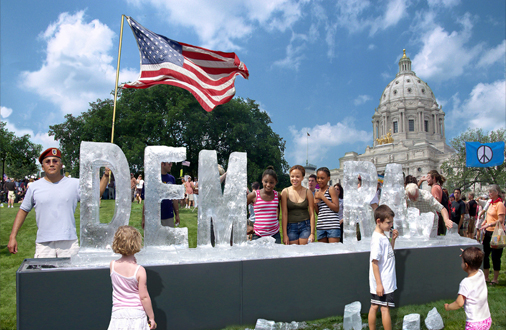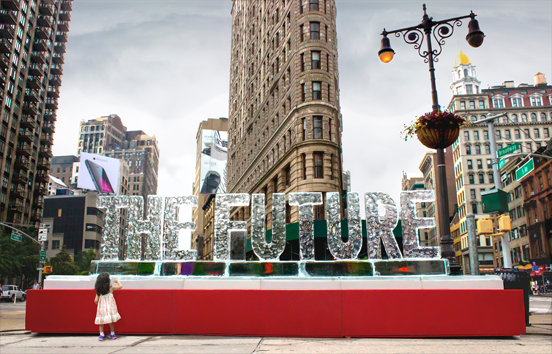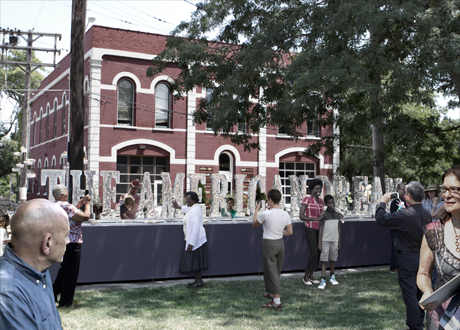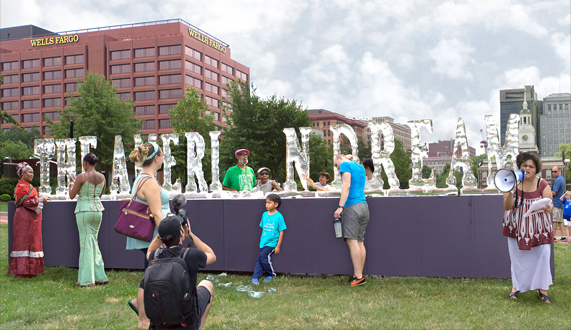by Marisa Lerer and Jennifer K. Favorite
The United States has a particularly long election cycle. This year’s presidential election campaigns seem extraordinarily stretched due to the particularly tempestuous political climate. Grueling political rivalries have been part of U.S. politics since the beginning. Historically and in the past decade, public art, such as Shepard Fairey’s now iconic Barack Obama Hope poster, has played a key role in navigating and conveying politically charged messages. Public art has, in addition, fostered dialogues on key political issues, with Ligorano/Reese’s ice sculpture The American Dream being a prime example. Ligorano/Reese is a collaboration of Nora Ligorano and Marshall Reese, who have been working together since the 1980s. They have generously shared their thoughts on public art’s role in the political sphere.*
Your site-specific temporary Melted Away series consists of one or more large-scale words carved in ice, installed in a public space, and allowed to melt over time. What is the process for choosing the terms and ideas that you visually insert into the public sphere?
The process for choosing the words for our temporary monuments is really an organic one. We choose words that reference current trends in political speech, and that have a powerful resonance as they disappear. We aim to make an impact on society to extend the discourse, bringing up issues that the media glosses over, in order to put weight back into the meaning of the words. We follow the trends in the news and build on that. We choose words that reach the public in a familiar, non-threatening way. Equally we choose our material, ice, to be inviting and to draw a public to open up discourse.
In 2008, after 8 years of the Bush Administration, the passage of the Patriot Act, and the War on Terror, we really sensed a weakening of institutions in the country and of democracy. We were reading de Tocqueville’s Democracy in America at the time and that seemed to have the [right] ring. The word “Democracy” was the first sculpture we melted down.

The State of Things, Republican National Convention, September 1, 2008, Saint Paul Capitol, Saint Paul, MN.
Photo by Nora Ligorano
We see these pieces as social sculptures. The public event is built out of a number of components: there’s the sculpture, which we film as it disappears to make time-lapse videos, and to stream it live. We also interview people on the street to record their reactions to witnessing the melting of the idea behind the word and what that means to them, to society. We’re trying to expand the audience for the sculptures and extend their time/space by using film and the internet.
In 2008 we were commissioned by Provisions Library in Washington D.C., to take Democracy to the Republican and Democratic conventions. An opportunity like this certainly helped to frame the word. To place it at the conventions is a type of political theater, a unique stage unto itself. Siting the pieces at the conventions highlights the importance and power of the installations. They’re as equally important as the word itself.
After the conventions in 2008, we followed very quickly with Main Street Meltdown, a sculpture of the word “Economy” that we placed in front of the New York State Supreme Court building on the 79th anniversary of the Great Depression. This was the last week of the 2008 campaign before the general election and just two weeks after Lehman Brothers went bankrupt and the financial crisis worsened. People really responded to it, because it captured the sense of anxiety they felt. In 2012 we melted down “Middle Class” in Tampa and Charlotte. We saw the disappearance of the middle class as a political crisis. At the conventions, we built on the previous works with streaming video and photography and we also published a four-page newspaper to give out for free with essays about the middle class disappearing and about our artwork.
Sometimes, we do a “dry run” in the garden of Jim Kempner Fine Art, where we can better control the photography and filming. In 2010 we filmed the time-lapse video of the Middle Class disappearing in Kempner’s garden, editing it with a voiceover of Senator Bernie Sanders’s filibuster against the Bush tax cuts for the wealthy at the end of that year. (The Speech, Nation Books, 2011). Sanders uploaded our video to his Senate website, it was seen by over 60,000 viewers, and it went viral. Now looking back, that was very prescient and clearly foreshadowed his national campaign this year, and the significance and impact of his ideas.
The use of ice as a material makes perfect sense to talk about climate issues. It’s solid, strong, yet also fragile. It turns to liquid, it has a crystalline quality and it’s also a popular art form. People can approach it; they touch it. It reacts and vanishes due to climatic conditions.
We decided to install the words “The Future” during the People’s Climate March in 2014 in front of the Flatiron building in New York City. The event was sponsored by 350.org. With it we invited writers, poets, and artists to come to the site for short-term writers’ residencies. Their texts and reactions were posted live as the sculpture disappeared. This has become a key component which we expanded on in 2016; the streaming video has become key as well.

Dawn of the Anthropocene, People’s Climate March, September 21, 2014, Flatiron North Plaza, New York City.
Photo by Nora Ligorano
We always wanted to build and amplify the social space of the sculptures, to expand their time sense. Streaming is the way we do it and from the reactions we receive, it’s a very important aspect of this project. People really like to see it from afar, it emphasizes their performative nature, and the mic on the camera is live, so there’s a real sense of being there. It’s seen from all over the world. What was so amazing during the Climate March is that people were taking selfies in front of the melting FUTURE! Just think about it, sometime in the future they’ll look back at their images of themselves in front of the future! The future to come as it disappears!

The American Dream Project, Republican National Convention, July 19, 2016, Transformer Station, Cleveland, OH.
Photo by Nora Ligorano
We just melted “The American Dream” at the 2016 Republican and Democratic National conventions, expanding on the live character of the pieces even further. In Cleveland, The City Club, the oldest free speech organization in the country, organized a four-hour afternoon discussion called “The American Dream: A Symposium at the Intersection of Art and Politics” with community leaders and artists on the day the sculpture was exhibited. It was really substantial and added an important dimension to the work. We try to avoid helicoptering in; we want these pieces to be local and expand out from that and try to make these connections to build on the issues pertinent to where we’re doing the piece. In Philadelphia, we hosted a writers’ residency alongside the installation. Some of the writers read texts aloud with a bullhorn and also spoke into a mic over the video stream. We also give something for the public to take away with them and, like in 2012, we published another newspaper with essays by Charles Bernstein, Edwin Torres, and a poem by Erica Hunt.
What needs to be emphasized is the metamorphosis of the word changing and breaking apart. In a way the movement of the word, how it disappears is a kind of syntax. And it resonates in so many ways. In the time the typical viewer looks at an artwork in a museum, one minute, maybe less than that, the sculpture won’t change. But if they come back after one hour, two hours, it will be completely different and have a different sense. When we unveil the sculpture, they’re strong and crystalline, like glass. But over time they diminish, they weaken, break apart and crack. It’s a totally different reading.
Your ice sculptures are charged with political content, and the sites where you choose to exhibit the monuments further their political charge. For example, you have installed many of your sculptures by libraries. Could you elaborate on your site selection process?
We began making temporary public artworks in 1994. Location, the site is very important. It frames the installation. At that time, we looked at significant public institutions, perhaps ones that are overlooked as cultural sites to place our work. One of the most important of these, we felt, primarily for their role in free speech and free information in society is the library.
We were fortunate that the New York Public Library Donnell Library Center, located on one of the most culturally significant streets in the country, across from MoMA, had a program in the 1990s for media artists to install works in their front windows. This was at the height of the Culture Wars, and we approached them with “Acid Migration of Culture.” Acid Migration is a problem in library collections, as paper acidifies in books it can move across the entire collection and contaminate it. We thought that was an apt metaphor for what had been transpiring in our country. At first, Anne Hofmann, the Donnell’s former Chief Librarian, reacted, “Oh, it’s so good that you’re doing something about library conservation,” and we responded, “Well not exactly…” worried that maybe she wouldn’t like our plan.
We were the first artists ever to use the entire façade of the entrance. Usually artists used one set of windows to the side of the front doors. We made a 48-foot long photo mural (this is before digital printing) of a giant dictionary of cultural terms that people walked through the center of-the gutter of the book- to enter and leave the library. The book had foxing and worm holes where we inserted four video monitors from which passersby could read statements from politicians, artists, and social commentators on the role of art and public funding.
Their texts were scrolled over images of their portrait. Because there was so much hyperbole at the time, we felt the public needed to read these opinions on the role in society for themselves. People would pass by and pause to read statements by Jesse Helms, Karen Finley, Andres Serano, Claiborn Pell, and others.
Acid Migration of Culture had an internet component, too: we posted a survey on artswire.org and included those comments by people who responded to it in the video text as well. Almost 15 years before installing Democracy in Denver, we were making a public artwork with a networking component.
Ten years later in 2004 we did another library project on censorship called Free Speech Zone. The first version was at the Brooklyn Public Library Grand Army Plaza branch in the second-floor mezzanine. We made backlit duratrans (transparent displays) images of library users, “patrons,” blindfolded. They became elements of an electronic triptych. They bookended a center panel ticker sign, while passages and titles of challenged and banned books flickered across it.
We redid Free Speech Zone in September 2005 at the Donnell Library, putting the triptychs in the front windows flanking the entrance. The last week of that month is Banned Book Week. We partnered with the National Coalition Against Censorship and the PEN American Center to host an evening of readings by authors of banned and challenged books. Judy Blume, Deborah Hautzig, Robert Lipsyte, Walter Dean Myers, Phyllis Reynolds Naylor, Peter Sís, and Rita Williams-Garcia read. There was so much interest in the event. It was the first time the New York Public Library streamed a live event from a branch library. Public reading, networking and streaming have always been a part of these works of ours. You can access the webcast here.
What were some of the responses by participants and visitors to “The American Dream Project,” installed at the 2016 Republican National Convention in Cleveland and at the 2016 Democratic National Convention in Philadelphia? How did the reactions align or converge with the general climates of the conventions?

The American Dream Project, Democratic National Convention, July 25, 2016, Independence Mall, Philadelphia, PA.
Photo by Nora Ligorano
People were saddened and dismayed to see the “American Dream” disappear. [Insert Image: The American Dream Project-Philadelphia] Seeing these words, this phrase, disappear before your very eyes suspends disbelief. We wanted to really focus on how society is changing, the erosion of opportunity, inequity, and to question the existence of the Dream, what it is and who is it for? This was clear in both Cleveland and Philadelphia. The New Yorker produced a slide show with interviews of the public, Nora and I were so moved by it. We too were interviewing people. I asked them a series of questions about seeing the American Dream disappear, what it meant to them, and how they felt.
We plan to edit a multi-screen video piece with this material and the time-lapses. The reaction in Cleveland expressed in that New Yorker piece accurately captured the mood of the people who came to the installation. In Philadelphia, it was so hot—with a 108-degree heat index—that the sculpture barely lasted more than 3 hours. The writers’ interactions were so powerful; their blogging and reading through the bullhorn created a 3+ hour performative space, which drew a very diverse public.
How do you track responses or otherwise document your public art installations? How has the public’s interaction with the works shifted since 2008, when you began your Melted Away series at the 2008 U.S. presidential conventions?
Since these works are temporary, it is important to track, document the public’s response, and consider ways in which to expand our audience. We really see these as social sculptures with an active internet presence. We invite other writers to comment on the action and post it on the Melted Away website. It’s an expanded documentary form combining moving images, stills, texts, sound, and printed matter. We also try as best we can to have press on site to report about the installation. Without that type of dissemination, the work, its meaning and raison d'être run the risk of preaching to the converted.
It’s a risk one takes, but the press presence ensures a great public. There’s been a clear development to how we put these together. We haven’t always been able to implement the various components as well as we would have liked. Even though we streamed “Democracy” in Denver, we couldn’t do it in St. Paul or for the “Economy” in downtown New York due to resources. With the “Middle Class” in Charlotte and Tampa we could. It worked remotely and the response was so surprisingly good that we decided it was necessary to keep it in.
It’s also important to have dedicated websites for each project to upload videos and stills as it’s happening and that’s been a component. With the “Middle Class” the websites became more an aggregate for all of them, we decided to tie the social media, Twitter and Facebook to a single name: “Melted Away.” Social media has become an important media tool, with a great leap forward during the Future meltdown. It’s necessary to use all these social media tools. We realized that through the reaction to “The Future”—so many people told us they saw it. And how did they see it? On their newsfeed in Facebook, through instagram selfies, and tweets!
These are really hybrid public pieces somewhere between performances and film/photo shoots. One of the ways we got a permit for “Economy” was by saying we were doing a photo shoot. What we didn’t exactly tell the city was that in addition to the photo shoot, we were installing a 2,000 pound ice sculpture that would last for hours. We said we’re going to do stills in Foley Square and needed a permit. No problem. It worked. We applied for that permit two weeks before the event. Permitting is always an issue, reinforcing how difficult it is to do public art in public space. There’s simply not enough public space left, so much is now privately controlled and when you do an event during a national security event like the conventions, the constrictions are even more difficult. The political parties have carte-blanche use of the city, releasing spaces they don’t use closer to the date of the convention. The permitting is a type of pre-censorship limiting public speech and proscribing its effectiveness. The authorities create free speech zones far away from the sites or anybody you’d want to have hear your point of view.
Our work penetrates and interrogates the public in a gentle yet thoughtful way. It questions social constructs yet appears as common as apple pie. It’s incredible to hear people’s reactions to an “Economy” in meltdown, breaking apart – they know it, but seeing it crumble gives another sense altogether! Or experiencing “The Future” disappearing, that’s the real tragedy of global warming, the future of our children, their children and the planet is slipping away from us.
Do you have any future projects under production that relate to the U.S. presidential election this fall?
We’re in the process of doing the post-production for the “American Dream,” which means updating the website, organizing and making the imagery. We edition a digital print for our ice letter sponsors and edit the video. Most likely “The American Dream” will be a multi-screen piece when we finish it.
And there’s another election year project Political Advertisement currently in production, which Marshall has been doing with the Spanish artist [Antoni] Muntadas since 1984. It tracks the development of presidential campaign advertising. It will be screening around the country the first week of November, just before the general election.
*This interview has been lightly edited and condensed throughout.

The State of Things, Republican National Convention, September 1, 2008, Saint Paul Capitol, Saint Paul, MN.
Photo by Nora Ligorano

Dawn of the Anthropocene, People’s Climate March, September 21, 2014, Flatiron North Plaza, New York City.
Photo by Nora Ligorano

The American Dream Project, Republican National Convention, July 19, 2016, Transformer Station, Cleveland, OH.
Photo by Nora Ligorano

The American Dream Project, Democratic National Convention, July 25, 2016, Independence Mall, Philadelphia, PA.
Photo by Nora Ligorano



